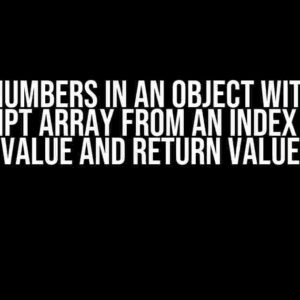When it comes to optimizing your code, understanding the performance characteristics of different data structures is crucial. In this article, we’ll dive deep into the world of lists and sets, exploring why searching performance in lists is often better than in sets. Buckle up, and let’s get started!
The Basics: Lists and Sets
Before we dive into the performance comparison, it’s essential to understand the fundamental differences between lists and sets.
Lists: Ordered and Indexable
A list is a collection of elements that can be accessed by their index. This means that each element in the list has a unique position, and you can retrieve or modify elements using their index.
my_list = [1, 2, 3, 4, 5]
print(my_list[0]) # Output: 1
my_list[0] = 10
print(my_list) # Output: [10, 2, 3, 4, 5]Sets: Unordered and Uniqueness
A set is an unordered collection of unique elements. You cannot access elements in a set by their index, as the order is not guaranteed. Sets are ideal for storing unique values and performing set operations.
my_set = {1, 2, 3, 4, 5}
print(my_set) # Output: {1, 2, 3, 4, 5} (order may vary)
my_set.add(6)
print(my_set) # Output: {1, 2, 3, 4, 5, 6} (order may vary)Searching Performance: Lists vs. Sets
Now that we’ve covered the basics, let’s explore the searching performance of lists and sets.
Searching in Lists
When searching for an element in a list, you can use the `in` operator, which has an average time complexity of O(n), where n is the length of the list. This means that the search operation has to iterate through the list until it finds the target element or reaches the end of the list.
my_list = [1, 2, 3, 4, 5]
target_element = 3
if target_element in my_list:
print("Element found!")
else:
print("Element not found!")Searching in Sets
Searching for an element in a set is also possible using the `in` operator. However, sets have an average time complexity of O(1) for search operations, making them much faster than lists for large datasets. This is because sets use a hash table to store elements, allowing for fast lookups.
my_set = {1, 2, 3, 4, 5}
target_element = 3
if target_element in my_set:
print("Element found!")
else:
print("Element not found!")So, why is searching in sets seemingly faster? The answer lies in the underlying data structure. Sets use a hash table to store elements, which allows for fast lookups. However, this comes at the cost of slower insertion and deletion operations, as the hash table needs to be updated.
When to Choose Lists and When to Choose Sets
Now that we’ve discussed the searching performance of lists and sets, it’s essential to understand when to choose each data structure.
Use Lists When:
- You need to maintain a specific order of elements.
- You need to access elements by their index.
- You need to perform frequent insertions or deletions at specific positions.
Use Sets When:
- You need to store unique values.
- You need to perform fast lookups.
- You need to perform set operations (union, intersection, difference).
Real-World Scenarios: Lists vs. Sets
Let’s explore some real-world scenarios where lists and sets can be used.
Scenario 1: To-Do List App
In a to-do list app, you might want to store tasks in a list, as the order of tasks is important. You can use a list to store tasks, and then use indexing to access and modify tasks.
tasks = ["Buy milk", "Walk the dog", "Do laundry"]
tasks[0] = "Buy eggs"
print(tasks) # Output: ["Buy eggs", "Walk the dog", "Do laundry"]Scenario 2: Unique User IDs
In a user authentication system, you might want to store unique user IDs in a set. This ensures that each user ID is unique and allows for fast lookups.
user_ids = {1, 2, 3, 4, 5}
if 3 in user_ids:
print("User ID exists!")
else:
print("User ID does not exist!")Conclusion
In conclusion, while sets may seem like the obvious choice for searching performance, lists can be a better option in certain scenarios. By understanding the strengths and weaknesses of each data structure, you can make informed decisions and optimize your code for better performance.
Remember, when in doubt, ask yourself:
- Do I need to maintain a specific order of elements?
- Do I need to access elements by their index?
- Do I need to store unique values?
By answering these questions, you’ll be well on your way to choosing the right data structure for your needs.
| Data Structure | Searching Performance | Use Case |
|---|---|---|
| Lists | O(n) | Ordered and indexable, suitable for scenarios where order matters |
| Sets | O(1) | Unordered and unique, suitable for scenarios where fast lookups are crucial |
Happy coding!
Related articles:
- Exploring the World of Hash Tables
- A Beginner’s Guide to Data Structures in Python
- Optimizing Your Code: Tips and Tricks for Better Performance
Frequently Asked Question
Get the speed boost you need! Learn why searching performance in a list is better than in a set.
Why is searching in a list faster than in a set?
Searching in a list is faster because lists use index-based lookup, which allows for direct access to elements. This means that the search operation can jump straight to the target element, reducing the time complexity to O(1). In contrast, sets use a hash-based lookup, which requires iterating over all elements, making the search operation slower with a time complexity of O(n).
Does this mean lists are always the better choice?
Not exactly! While lists are faster for searching, sets have their own strengths. Sets are better suited for operations like union, intersection, and difference, and they automatically eliminate duplicates. Lists, on the other hand, can have duplicates and require more memory. It’s essential to choose the right data structure based on your specific use case.
How does the size of the data structure affect the search performance?
The size of the data structure plays a significant role in search performance. As the size of the list or set grows, the search time increases. However, lists tend to perform better with larger datasets since their index-based lookup remains efficient, whereas sets become slower due to the increased number of hash collisions.
What if I need to search for an element in both a list and a set?
If you need to search for an element in both a list and a set, it’s generally faster to search in the list first. If the element is not found in the list, then search in the set. This approach takes advantage of the list’s faster search performance while still utilizing the set’s unique features.
Are there any scenarios where searching in a set is faster than in a list?
Yes, there are cases where searching in a set can be faster. If the set is much smaller than the list and the element is likely to be in the set, searching in the set can be faster due to the reduced number of elements to iterate over. Additionally, if you’re using a language like Python, which has highly optimized set operations, searching in a set might be faster in certain scenarios.


